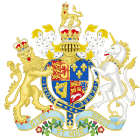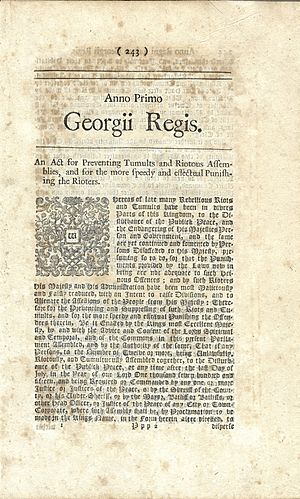Riot Act facts for kids

|
|
| Long title | An Act for Preventing Tumults and Riotous Assemblies, and for the more speedy and effectual Punishing the Rioters |
|---|---|
| Citation | 1 Geo. 1. St. 2. c. 5 |
| Dates | |
| Commencement | 1 August 1715 |
| Other legislation | |
| Repealed by | Statute Law (Repeals) Act 1973 |
|
Status: Repealed
|
|
The Riot Act was an important law in Great Britain. It allowed local officials to tell large groups of people (12 or more) to break up. If the group did not leave, they could face serious punishment. This law was also known as the Riot Act 1714 or 1715.
Its full name was "An Act for preventing tumults and riotous assemblies, and for the more speedy and effectual punishing the rioters." It became law on August 1, 1715. The Riot Act was later cancelled in England and Wales in 1967. Similar laws were made in British colonies like Australia and North America. Some of these laws are still in use today.
Today, if someone says they will "read the riot act" to you, it means they will give you a very strong warning. They are telling you to change your behavior or face consequences.
Contents
Why Was the Riot Act Needed?
The Riot Act of 1714 was created during a time of many public disturbances. There were riots happening across Great Britain. For example, the Sacheverell riots in 1710 and the Coronation riots in 1714. There were also riots in England in 1715.
The law stated that "many rebellious riots and tumults" were happening. It also said that the old laws were not strong enough. They did not stop people from causing such "heinous offences" (serious crimes).
What Did the Riot Act Say?
The Riot Act gave local leaders a way to deal with large crowds. These crowds were seen as "unlawfully, riotously, and tumultuously assembled together." This means they were gathered illegally, causing trouble, and being noisy.
How Officials Declared a Riot
Certain local officials could make a special announcement. This announcement ordered groups of twelve or more people to leave. If the group did not break up within one hour, anyone still there was guilty of a serious crime. This crime could be punished by death.
The announcement could be made by a mayor or justice of the peace in a town. In other areas, a sheriff or constable could read it. The official had to read the exact words from the law. If even a small part was missed, like "God save the King," convictions could be overturned.
The exact words that had to be read were:
Our sovereign lord the King chargeth and commandeth all persons, being assembled, immediately to disperse themselves, and peaceably to depart to their habitations, or to their lawful business, upon the pains contained in the act made in the first year of King George, for preventing tumults and riotous assemblies. God save the King.
In many places like Britain, Canada, and New Zealand, these words became part of the law. The saying "reading the Riot Act" comes directly from this legal requirement.
What Happened If People Didn't Listen?
If a crowd did not leave within one hour, officials could use force to make them disperse. Anyone helping to break up the crowd was protected by the law. They could not be sued or punished if people in the crowd were hurt or killed.
Because this law gave officials so much power, it was used in different ways. It helped keep order, but also sometimes for political reasons. A famous example was the Peterloo Massacre in 1819 in Manchester. During this event, a large crowd was attacked by cavalry after the Riot Act was read.
Other Rules in the Act
The Riot Act also made it a serious crime, punishable by death, to damage buildings. This included places of worship, houses, barns, and stables. This applied if the damage was caused by a large, unruly crowd.
If buildings were damaged outside of towns, the local area (called a "hundred") had to pay for the repairs. This encouraged people in the area to try and stop riots. They wanted to avoid paying for the damage.
People had one year to bring charges under this act.
The Riot Act's Journey Through History
The Riot Act sometimes caused confusion. During the Gordon Riots of 1780, officials were unsure if they could act without reading the Riot Act first. Later, a judge named Lord Mansfield clarified this. He said the Riot Act did not stop officials from using force to stop a violent riot. It just added a new crime: not leaving after the Riot Act was read.
The Riot Act was read before several famous events. These include the Peterloo Massacre in 1819 and the Bristol Riots at Queen's Square in 1831. These events were connected to the old Parliament system, which was later changed.
In Canada, the Riot Act was read during the Upper Canada Rebellion of 1837. This led to changes in how Canada was governed.
Over time, the death penalty for breaking the Riot Act was changed. In 1837, it became "transportation for life." This meant being sent away to a distant colony as punishment.
The Riot Act slowly stopped being used. The last time it was definitely read in England was in Birkenhead in 1919. This was during a police strike. Troops were called in, and a magistrate read the Riot Act. However, none of the rioters were charged with the serious crime from the act.
The Riot Act was officially cancelled for the United Kingdom in 1973.
The Riot Act Around the World
The Riot Act became law in many countries that were once British colonies. This includes countries in North America, like the United States and Canada.
In many countries that use British law, smaller disturbances can be called an "unlawful assembly." Officials can order these groups to break up. Not obeying this order is usually a less serious crime.
Australia
Some Australian states have laws similar to the Riot Act. For example, in Victoria, a law from 1958 allowed officials to break up crowds. They would use words like:
Our sovereign lady the Queen doth strictly charge and command all manner of persons here assembled immediately to disperse themselves and peaceably depart to their own homes. God save the Queen.
Anyone who stayed after 15 minutes could be jailed. This law did not apply to crowds gathered for an election. The law also allowed officials to appoint citizens as "special police." These citizens were protected if they hurt or killed people while breaking up a crowd. This law was changed in 2007.
Belize
Belize, another former British colony, still has laws like the Riot Act. It was last read on January 21, 2005, during unrest there. The law says that officials can make a proclamation "in the King's name." This tells rioters to leave peacefully. If someone does not leave within one hour, they can be jailed for up to five years.
Canada
In Canada, the Riot Act is part of the country's Criminal Code. This federal law deals with how police can stop riots. A riot is defined as an "unlawful assembly" that starts to cause trouble. When 12 or more people are gathered unlawfully, officials can read a proclamation.
The proclamation in Canada says:
Her Majesty the Queen charges and commands all persons being assembled immediately to disperse and peaceably to depart to their habitations or to their lawful business on the pain of being guilty of an offence for which, on conviction, they may be sentenced to imprisonment for life. God save the Queen.
Unlike the original Riot Act, people in Canada have 30 minutes to leave. If the proclamation is ignored, the punishment can be life imprisonment. This also applies if someone stops the official from reading the proclamation.
The proclamation was read during the Winnipeg general strike of 1919. It was also read during the 2011 Vancouver Stanley Cup riot.
New Zealand
In New Zealand, the Riot Act was part of their Crimes Act 1961. The proclamation there was:
Her Majesty the Queen commands all of you to disperse immediately and to go quietly to your homes or to your lawful business, upon pain of being charged with an offence punishable by imprisonment for five years. God save the Queen.
However, the need to read the Riot Act was removed in 1987.
United States
In the United States, a riot act was passed in Massachusetts in 1786 during Shays' Rebellion.
At the national level, the idea of the Riot Act was included in the first Militia Act of 1792. This law allowed the President to order people to "disperse, and retire peaceably." If they did not, the President could use the military. Similar language is still in US law today.
Laws against causing riots were also added to US federal law in 1968. This was part of the Civil Rights Act of 1968.
What Does "Read the Riot Act" Mean Today?
Because officials had to read the Riot Act proclamation, the phrase "to read the Riot Act" became a common saying. It means to give someone a very strong warning or a severe telling-off. It suggests that there will be bad consequences if the person does not listen. This phrase is still used often in the English language.
See also
- Black Act
- Riot Acts
- Public Order Act 1986
- Criminal Justice and Public Order Act 1994
- Serious Organised Crime and Police Act 2005



